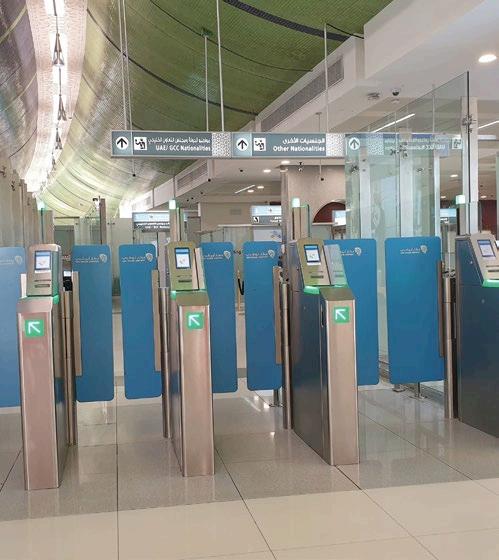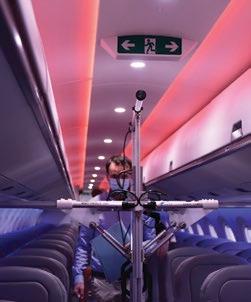
10 minute read
DOORS TO AUTOMATIC
DOORS TO
THE TECHNOLOGY HELPING TO MAKE THE REGION’S AIRPORTS SAFE
AUTOMATIC
WORDS: GEMMA GREENWOOD
The impact of the pandemic on air travel has been severe with global passenger traffic down some 48 per cent year on year at the end of November 2020, according to data by SITA, an IT and telecommunication services provider to the air transport industry.
“Regaining passenger confidence has become a critical factor for airlines and airports to weather the ongoing economic storm,” says SITA President, Middle East, India and Africa, Hani El-Assaad.
“The industry has to achieve far more with far less to thrive in a significantly smaller market where passenger numbers may be uncertain for years to come.”
Against this backdrop, the airline industry must quickly shift its focus from immediate actions like asking passengers to wear masks and apply hand sanitisers to longer-term and more sustainable solutions, he says, citing automation of operations as key to reducing queues and touchpoints at the airport as passenger volumes recover.
“Resilient and agile systems that increase efficiencies and can respond to unpredictable fluxes in passenger numbers will greatly influence those who can adapt and thrive in this new reality,” continues El-Assaad. “The pandemic represents a new 9/11 moment for air travel and how we respond will define our industry for decades to come.”
SITA has been working with many of the Middle East’s major airports to deliver low-touch solutions focused on automation and biometrics. Here are a few examples of the technology passengers can expect to encounter when they fly in or out of the region.
Passenger flow management

Abu Dhabi Airports Company (ADAC) has adopted SITA’s automatic boarding pass validation system to facilitate a smooth and easy passenger experience, known as the automated Traveller Document Authentication System (TDAS).
TDAS uses SITA Passenger Flow Management technology to automatically verify original, mobile, or home-printed boarding passes before passport control.
This makes the process quick and simple by eliminating long queues and significantly reducing wait times for passengers.
TDAS has been installed in eight
The pandemic represents a new 9/11 moment for
air travel lanes. The system comprises automatic gates activated by both handheld and static boarding pass scanners. Barcodes on the passes are automatically scanned and validated. The data is then checked for duplicates and crossreferenced against the airport operational database and the airline’s departure control system. ABOVE: Automatic The system has been designed to gates at Abu Dhabi International Airport improve security at the airport and to ensure passengers are directed to LEFT: SITA’s mobile boarding pass the correct terminals and security technology checkpoints.

STEPS TO SAFE AIRPORT TRAVEL
SITA’s tips on how technology can overcome COVID-19-related challenges for air travel
1. Enable passengers to be ready to fly before the airport Travel authorisation, bag-drop, check in and more can be facilitated away from the airport to reduce passenger queuing and to enable more social distancing. This means passengers can arrive checked in and ‘ready to fly’. Health ETAs (Electronic Travel Authorisation) help further speed up the process. SITA uses biometrically enabled, secure mobile technology, which allows governments to instantly check digital declarations before passengers travel – minimising hassle and queuing at airports.
2. Enabling safer, easier passage through the airport A seamless journey through the airport is crucial to reducing the risk of COVID-19 infection. SITA gives passengers a contactless experience, thanks to biometrics capable of enrolling, then recognising faces with masks on and passengers being able to use their ‘mobile as a remote control for travel’. Touchless bag tagging and digital boarding pass stamps at security are just some of the examples of minimising the need for passengers to touch airport infrastructure or physically contact sta .
3. Safer on arrival and beyond SITA now provides health-aware border checks on arrival linked to pre-checked identity, journey and health information. Processing passengers via biometric-enabled gates or traditional border checkpoints is faster than ever and completely touchless, further reducing the time of exposure in the airport, congestion levels, and contact points. Passengers can also receive personal notifications advising bag arrival location and times to help avoid clustering in the baggage arrivals hall. And, in the unfortunate event of losing a bag, they can use mobile lost bag reporting to check the progress on any lost bags and connect to the airline.
RIGHT: Self check-in kiosks at Muscat International Airport BELOW: The Smart Path at Istanbul Airport IGA
Self check-in kiosks
Oman Airports uses SITA’s Self Check-in Kiosks to enhance the passenger experience at Muscat International Airport.
Ten kiosks enable passengers to check in and to print boarding passes and bag tags. is reduces queue times at the check-in counters, allowing passengers to relax. e kiosks are future-ready and provide a contactless check-in experience, empowering passengers to operate the kiosk with their own mobile phone. ey are also equipped to incorporate biometrics in the future, paving the way for a seamless biometrics-enabled journey through the airport.


Smart Path
SITA Smart Path, an automatic solution that helps passengers breeze through checkpoints using their face as their boarding pass, is integrated into the existing common-use airport infrastructure at Istanbul Airport IGA. e solution, which is rolled out across participating airlines’ Departure Control Systems (DCS), o ers passengers a seamless, secure and cost-e ective customer experience.
Smart Path in IGA is also being tested on the following touchpoints and systems: • Enrolment on SITA Common
Use Terminals (CUTE) at the check-in desk • Seamless integration with airlines’
DCS systems and SITA Local departure control system • Gate access airside on SITA
Passenger Check automated gates • Access to the IGA’s VIP lounge • Aircra boarding


ON-BOARD UPDATE
Contactless technology is not only transforming the airport experience but translating to new on-board experiences. Etihad Airways recently launched a new trial with digital newspaper and magazine app Pressreader allowing passengers to download publications before their flight, eliminating the need for paper versions. The initiative gives passengers access to more than 7,000 titles from 120 countries from 30 hours before departure. Customers can download unlimited publications, either by opening the Etihad Airways app or by clicking on the Pressreader link in their check-in reminder email. A selection of titles will also be available on Etihad’s IFE system inflight. Once downloaded the publications are free to keep.
Meanwhile, air services provider dnata has partnered with Swiss technology firm Uveya to trial new ultraviolet (UV) technology for aircraft cabin sanitisation. dnata’s enhanced cabin cleaning service was trialled on board the aircraft of Swiss regional carrier Helvetic Airways. Uveya’s cutting-edge solution uses UV-C rays to disinfect the interior of the aircraft. During the cleaning process, an autonomous sterilisation robot emits concentrated UV-C light across the cabin. The device can e ectively kill more than 99 per cent of bacteria and pathogens, including Coronavirus, in the air and on all surfaces in a few minutes, without using any chemicals.
8

SHARJAH
4

WORDS GEMMA GREENWOOD

1
A Sharjah stopover promises visitors an authentic Arabian experience, thanks to the emirate’s rich cultural and natural heritage
Sharjah is arguably one of the UAE’s most diverse emirates, known for its cultural attractions, natural beauty, family friendly activities and increasingly, its unique ecotourism experiences. If you are taking a quick trip to the city for business, set some time aside to discover a few destination highlights, which range from museums, community venues and libraries to beautiful parks, beaches and mountainous beauty spots. Here is a snapshot of must-visits; just take your pick. 1 Browse through The House of Wisdom e House of Wisdom is Sharjah’s new state-of-the-art public library, which opened to the public in December 2020. It is a symbol of Sharjah’s commitment to cultural heritage preservation following its selection by UNESCO as the host city for World Book Capital in April 2019. e modern landmark features 15 spacious lobbies and halls that are home to 305,000 books, 200,000 of which are in digital format and 11,000 of which are written in multiple languages. It is a library for all ages with ‘ e Little Reader’ area dedicated to children and packed with some 2,000 books. houseofwisdom.ae 2 Go back to the future at the Flying Saucer e Flying Saucer, an iconic architectural landmark in Sharjah since the 1970s, was recently restored and renovated by the Sharjah Art Foundation and reopened to the public in September 2020. e space-age-inspired building o ers new outdoor areas and community spaces, which include a multi-activity café around a sunken courtyard with a library and multiple screening walls. e Flying Saucer is now being pitched as a premium venue for hosting social events, performances, outdoor art installations and other entertainment, so it’s worth considering for your next corporate gathering too.
sharjahart.org



5
3
7
3 Take a stroll around Shees Park is spectacular new park, located near the village of Shis in Khorfakkan (Sharjah’s Eastern Region), opened on October 15, 2020 and promises visitors mountain views and modern recreational facilities. Featuring beautiful lakes, mountain terraces, meandering walkways, splendid viewing decks, a play area, 32 shaded seats, an outdoor theatre that can accommodate up to 70 people and a barbecue area, there is plenty to keep you occupied or you can simply sit back and relax. Don’t miss the 25-metrehigh manmade waterfall, considered a key park attraction. 4 Row your boat at Al Rafisah Dam A pleasure ground for picnics and leisure boating for the past 40 years, Al Ra sah Dam, located at the foot of the Hajar mountains, has lashings of rustic charm, but thanks to a recent rejuvenation project, o ers plenty of modern amenities too, including a new visitor centre and rest area. It is a hideaway for nature lovers and adventure seekers but o ers easy access to key facilities such as a mosque, outdoor play areas for kids, parking areas, a supermarket and a famous local restaurant overlooking the lake. 5 Get theatrical at Khorfakkan Amphitheatre e Khorfakkan Amphitheatre, which sits at the foot of Al Sayed Mountain, is the newest landmark in Sharjah’s Eastern Region and is worth a visit for its stunning architecture and breathtaking views of the beach and the city. 6 Cave-in to spectacular views at Khorfakkan Waterfall Located next to the Khorfakkan Amphitheatre, the Khorfakkan Waterfall is one of the most famous attractions in the district. Standing 45 metres tall, 11 metres wide and 43 metres above sea level, the structure treats visitors to window views of water cascading from the top of the cave to the bottom of the mountain. It is an unforgettable treat for the senses. 7 Hike the historic trails at Khorfakkan and Al Rabi Tower ese famous towers in Khorfakkan are considered prime viewing spots, boasting panoramic vistas of the valley, all the way to the sea. Both have been restored and serve as the starting point to the historic hiking trail, which leads to Khorfakkan’s highest mountain. 8 Sit back and relax at Khorfakkan Beach Khorfakkan’s beach park is an outdoor recreational venue geared up for beachgoers, swimmers, tness fanatics and leisure seekers. Facilities include jogging and cycling tracks, showers and changing facilities, football and basketball venues, a BBQ area, children’s playground, open theatre, dining options ranging from restaurants to kiosks, plus parking and a few retail outlets.










